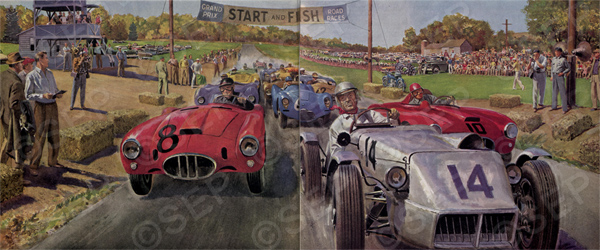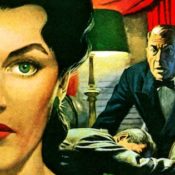
by Frank Leon Smith
Illustration by Peter Helck
Click image to enlarge.
“Motors roaring around the track, skidding on the turns, battles for position, shouting crowds—could even these make the heart of the girl from Boston beat faster?” Frank Leon Smith asks in the 1946 story “Keep the Girl on the Fence.” We don’t know about the girl in the story, but it works during race season every year, in recognition of which, we bring you some midcentury illustrations of race cars.
Auto racing stories were popular in the Post in the ’40s and ’50s, and although the titles were sometimes melodramatic — “Murder Car,” “The Crowd Screamed” — a common denominator was the exciting illustrations by artist Peter Helck (1893-1988).

by William Campbell Gault
Illustration by Peter Helck
Click image to enlarge.
“The black job roared into second place, but its driver wasn’t trying to win. He wanted to kill the man ahead,” declares the intro to 1951’s “Murder Car” by William Campbell Gault. Although some of the fiction was overly theatrical, Helck was serious about the fast-paced scenes. He was also earnest about car racing, a passion honed as a young man when he witnessed the historic 1906 Vanderbilt Cup Race, featuring an American car built to beat the Europeans. Known as “Old 16,” the car won the Vanderbilt two years later in 1908.

from “Keeping Posted”
December 28, 1946
Click image to enlarge.
“Old 16 was built when the American automobile, then only a fast-growing youngster, first challenged the European builders,” wrote Post editors in 1946. “Motoring was just becoming something more than a fashionable—and pretty daring—sport. Two things were at stake: prestige and the booming American automobile market. Citizens of substance, if they had decided to trust their lives in one of these smelly new gas buggies, liked to buy European cars. There was a feeling that nothing built on this side of the water could equal such swank European cars.”
Helck acquired the legendary race car in the early ’40s. “Every time I take Old 16 out for a run, I recall the men who handled cars of that era—under the road and tire conditions they faced — and my admiration for their capabilities becomes a bit fanatic.”

by William Campbell Gault
Illustration by Peter Helck
Click image to enlarge.
“It was the last lap of 100 miles of murder that he saw a car broadsiding in front of him,” the lead-in to this 1952 story declares, “ready to spill—and [here comes the title], ‘The Crowd Screamed.’” Melodrama aside, this is an all-but-live-action illustration.
Though Helck was best known for these fast-action scenes, he did a great deal of industrial commercial art as well. One testament to the variety of his illustrative skill is his work for Post sister publication, Country Gentleman, with scenes of a more bucolic nature.
[You can view Helck’s rustic scenes here, or visit Art.com to purchase.]
During his life, Helck described himself as an “auto addict” and wrote two books on racing—“The Checkered Flag” in 1961 and “Great Auto Races” in 1976—in addition to numerous magazine articles on the topic.

by A. Stanley Kramer
Illustration by Peter Helck
Click image to enlarge.
Learn more about the life and works of Peter Helck at Peter Helck, American Artist, a website maintained by the artist’s son and grandson.
Become a Saturday Evening Post member and enjoy unlimited access. Subscribe now



